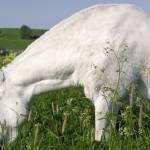Roach and Sway: Problems of the Horse’s Back

One telltale sign of aging, especially as horses segue into their late 20s and 30s, is progressive dipping or swaying of the back. Age-related swayback is no different than the grizzling of the facial hair or the deepening of the hollows above the eyes. They are usual signs of aging. Proper care and management of aged horses, whether they are swaybacked or not, will ensure their well-being.
Not all horses acquire a swayback with time, however. Some are born with this deformity. Also called lordosis, swayback does not necessarily preclude affected horses from being ridden, though saddle fit can sometimes be incredibly difficult, if not impossible. Congenital swayback is usually noticeable at birth, and it generally worsens with age.
Bloodlines of certain breeds are predisposed to swayback. Recent research has led scientists to uncover genetic markers in the case of certain bloodlines within the American Saddlebred breed.
Roach-backed horses are less common than swaybacked ones. Roach back, known also as kyphosis, occurs occasionally in young horses that grow rapidly. Typically, onset happens after weaning at six to nine months of age. The dorsal processes of the lumbar vertebrae are unusually tall, giving the animal a characteristic hump-backed appearance.
Some researchers believe both lordosis and kyphosis are the result of fetal malpositioning.








